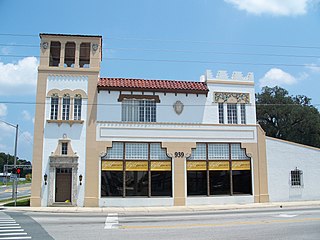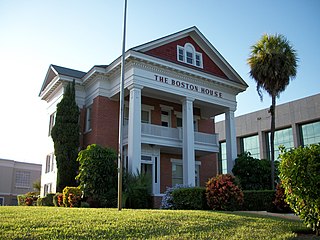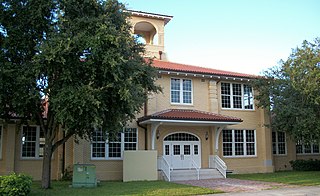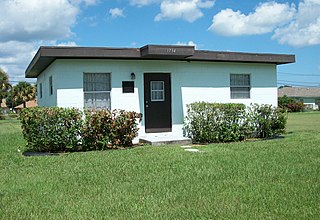
Old Fort Pierce Park is the site of Fort Pierce, a military installation constructed by the U.S. Army in Florida with the purpose of being a main supply depot for the army during the Second Seminole War. The modern town of Fort Pierce derives its name from this installation.

The Old Town Sebastian Historic District, East is a U.S. historic district located in Sebastian, Florida. The district is bounded by Main and Washington Streets, Riverside Drive, and the FEC Railroad. It contains 13 historic buildings.

The Downtown Miami Historic District is a U.S. historic district located in the CBD of Downtown Miami, Florida. The district is bounded by Miami Court, North Third Street, West Third Avenue, and South Second Street. It contains 60 historic buildings. A large portion the buildings in the historic district were built during the Florida land boom of the 1920s, when Miami experienced rapid population growth. Many of the older structures from before the 1920s, were smaller scale buildings and homes from the Miami pioneer era of the mid and late-19th century. Palm Cottage, built in 1897 is a home from the pioneer era that is still standing, however, few of these original homes remain.

The Coca-Cola Bottling Plant is an historic building located at 939 North Magnolia Avenue in Ocala, Florida, United States. Built in 1939, it was designed by Fort Lauderdale architect Courtney Stewart in the Mission/Spanish Revival style of architecture. On May 4, 1979, it was added to the U.S. National Register of Historic Places. Now owned and operated by Gartner Group, Inc. The building is the site of Grand Pointe Ocala, the cities premier event and conference center.

Fort Foster is a Second Seminole War era fort in central Florida, located 9 miles (14 km) south of current-day Zephyrhills in Pasco County.

Yellow Bluff Fort Historic State Park is a Florida State Park in Jacksonville, Florida. It is located near the mouth of the St. Johns River, a mile south of State Road 105 on New Berlin Road, in the cities Northside area. On September 29, 1970, it was added to the U.S. National Register of Historic Places.

The Pierce Site is a Pre-Columbian archaeological site in Apalachicola, Florida. It is located approximately 1 mile northwest of Apalachicola on 12th Street. On January 11, 1974, it was added to the U.S. National Register of Historic Places. It was occupied during the Middle Woodland Period, which includes ceramics of early Weeden Island and Swift Creek types. It also was occupied during the late prehistoric Fort Walton Period.

The Lyric Theatre is a historic theater located at 59 Southwest Flagler Avenue in downtown Stuart, Florida. The building fronts on its north side on Southwest Osceola Street. Built to serve as a movie house, it is now used primarily as a stage and music venue. Additions were made on the west side to provide back stage space for these new uses. The additions also face on both streets. On November 12, 1993, it was added to the U.S. National Register of Historic Places.

The Sunrise Theatre is a historic theater in Fort Pierce, Florida. It is located at 117 South 2nd Street. Built in 1922 by builder C.E. Cahow, the Sunrise Theatre was designed in the Mediterranean Revival Style by architect John N. Sherwood. The theatre earned its reputation for becoming the cultural center of the city of Fort Pierce as well as being the greatest and biggest cultural institution in Florida at the time. Opening day was August 1, 1923. The theater closed in 1983 after it had fallen into disrepair. It later partially reopened in 1999 after a $750,000 grant was awarded to renovate and restore the structure to its former condition. On December 7, 2001, it was added to the U.S. National Register of Historic Places. After a complete renovation including adding additional support areas in 2005, the venue opened in January 2006. It now presents a wide variety of entertainment events from local groups to world-famous artists such as Willie Nelson, Bill Cosby, Itzhak Perlman, Diana Ross, 3 Dog Night, Lindsey Buckingham, Bryan Adams, Vince Gill, Tony Bennett, Ziggy Marley, the late Dave Brubeck plus Operas, Broadway Shows, Ballet, Rock and Jazz.

Built in 1926, the Casa Caprona is a historic building in Fort Pierce, Florida, USA. It is located at 2605 St. Lucie Boulevard. Designed in the Mediterranean Revival style by architects Arthur Beck and J.K. Shinn, it was envisioned as the centerpiece for the proposed winter community of San Lucie Plaza. However, due to the collapse of the Florida land boom, the project failed. On June 2, 1984, it was added to the U.S. National Register of Historic Places.

The Boston House is a historic building in downtown Fort Pierce, Florida. It is located at 239 South Indian River Drive. On April 11, 1985, it was added to the U.S. National Register of Historic Places. It is recognized for its unique mixture of Neo-classical and Georgian architecture. It is also recognized for its part in local history. On April 18, 2012, the AIA's Florida Chapter placed the building on its list of Florida Architecture: 100 Years. 100 Places as Cresthaven/Boston House.

Located at 315 Avenue A, the Old Fort Pierce City Hall is a historic building in downtown Fort Pierce, Florida. Designed with both Mediterranean Revival Style and Italian Renaissance Revival elements by architect William Hatcher, the structure was built in 1925 at the peak of the Florida land boom by builder C.E. Cahow.

The Old Fort Pierce Post Office is a historic building in Fort Pierce, Florida. It was built in 1935 by the Works Progress Administration and designed by architect Louis A. Simon in the Mission Revival Style. As a civic structure it provided the city with a place for chance meetings and neighborly interaction. It is located at 500 Orange Avenue. On February 11, 2002, it was added to the U.S. National Register of Historic Places.

Built in 1914, the Old St. Anastasia Catholic School is a historic school in Fort Pierce, Florida. It is located at 910 Orange Avenue. It was built by James P. McNichol, a senator from Philadelphia who fished in Fort Pierce during the winter, for the pastor that rode into town once a month. Along with the masonry school, McNichol had built a wooden church, rectory, and convent. Eventually the Catholic Mission would end in 1911 and the school was all that remained. On August 10, 2000, it was added to the U.S. National Register of Historic Places. After damage from Hurricane Frances and Jeanne, the structure was in a state of disrepair. The building has since been stabilized and awaits restoration.

The St. Lucie High School is a historic school in Fort Pierce, Florida. It is located at 1100 Delaware Avenue. On January 26, 1984, it was added to the U.S. National Register of Historic Places. The building was first called Fort Pierce High School. For many years it had been the only high school between Stuart and Melbourne. Originally designed by W.B. Camp, at one point it had been "the most magnificent, the most modernly planned and the most architecturally beautiful public school building in Florida." As the school grew, architects such as William Hatcher and Laurence Funke made additions in 1926 closely following the original construction.

The Zora Neale Hurston House is a historic house at 1734 Avenue L in Fort Pierce, Florida. Built in 1957, it was the home of author Zora Neale Hurston (1891-1960) from then until her death. On December 4, 1991, it was designated as a U.S. National Historic Landmark.

The Snell Arcade is a historic site in St. Petersburg, Florida. The building was designed by the architect Richard Kiehnel of Kiehnel and Elliott. Built in 1926, it is located at 405 Central Avenue. On November 4, 1982, it was added to the U.S. National Register of Historic Places. The Snell Arcade was developed by C. Perry Snell, a wealthy landowner and philanthropist.

The Pueblo Arcade is a historic building in Vero Beach, Florida. Located at 2044 14th Street, the Pueblo Arcade was built in the Mission/Spanish Revival style in 1926 by local contractors Blackford and Davis. This structure was very popular among the citizens of Vero Beach due to its ingenious design, prior to the introduction of Air Conditioning. It consisted of arcades with shop doorways opening onto a single hallway which opened to the street. The structure was restored by developer Robert L. Brackett and was added to the U.S. National Register of Historic Places on March 8, 1997. Prior to renovation, the location served as the flagship store for DuBose Jewelers, a regional jewelry store chain which opened in Vero in 1912.

The Ribault Club is an historic building on Fort George Island near Jacksonville, Florida. It is now home to the Fort George Island Visitor Center. The building was designed in a Colonial Revival architecture style and is credited to Maurice Fatio and Mellen Clark Greeley. It was added to the U.S. National Register of Historic Places on May 11, 2000 and is located on Fort George Road. It was built in 1928 for winter recreation and is considered a legacy of Fort George Island's resort era. Winter recreational opportunities included golf, tennis, hunting, fishing, and yachting. The building is listed as a Historic Landmark by the City of Jacksonville. It became part of the Fort George Island Cultural State Park in 1989.
Arcade Building may refer to:























